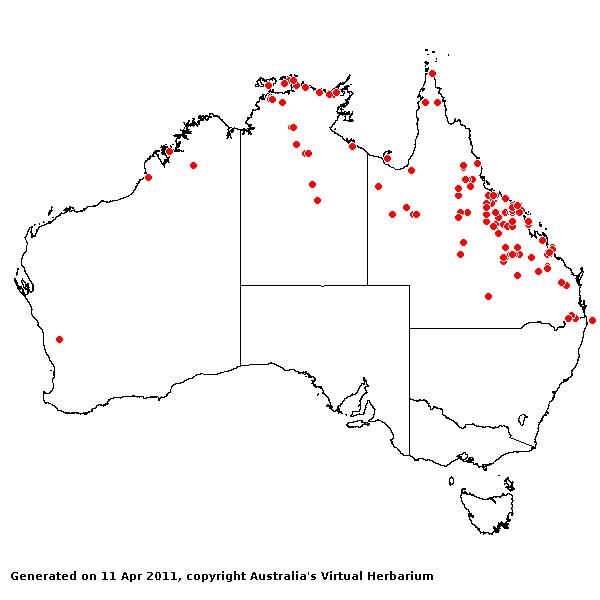Bothriochloa pertusa* (L.) A. Camus. Ann.
Soc. Linn. Lyon 76: 164 (1931).
Classification. (GPWG 2001) : Subfamily Panicoideae. Micraireae.
Basionym and/or
Replacement Name: Holcus pertusus
L. Mant. Pl. 2: 301–302 (1771).
Type of Basionym or
Protologue Information: LT: India orientalis (LINN-1212.16). LT designated
by Clayton, Kew Bull. 32: 4 (1977).
Key references
(books and floras): [1810]. R.Brown, Prodromus (201 as Andropogon
pertusus), [1878] G.Bentham, Flora Australiensis 7 (530 as Andropogon
pertusus), [1980] M.Lazarides, Tropical Grasses S.E.Asia (24),
[2002] D.Sharp & B.K.Simon, AusGrass, Grasses of Australia.
Illustrations:
[1983] J.C.Tothill & J.B.Hacker, Grasses of Southern Queensland
(128(7)).
Habit.
Perennial. Stolons present. Culms erect or geniculately ascending or prostrate,
15–70 cm tall. Mid-culm nodes glabrous or bearded. Ligule a fringed membrane, a
ciliolate membrane. Leaf-blades 5–30 cm long, 2.5–5 mm wide. Leaf-blade surface
glabrous or indumented.
Inflorescence.
Inflorescence subdigitate, with ramose branches. Central inflorescence axis 1–3
cm long. Rhachis fragile at the nodes.
Spikelets.
Spikelets sessile, 1 in the cluster. Companion spikelets pedicelled, 1 in the
cluster. Companion spikelets developed, containing empty lemmas or male, 3.8 mm
long. Fertile spikelets 2-flowered, the lower floret barren (rarely male), the
upper fertile, comprising 1 basal sterile florets, comprising 1 fertile
floret(s), without rachilla extension, elliptic, dorsally compressed, 3.5–4.5
mm long.
Glumes. Glumes
dissimilar, firmer than fertile lemma, shiny. Lower glume elliptic,
cartilaginous, without keels, 3–7 -nerved. Lower glume surface indumented.
Upper glume lanceolate, keeled, 1-keeled. Florets. Basal sterile florets
1, barren, without significant palea. Lemma of lower sterile floret hyaline.
Fertile lemma 1.8 mm
long, without keel. Lemma apex entire or lobed, awned, 1 -awned. Median
(principal) awn apical, 15–20 mm long overall, with a twisted column. Palea
absent. Anthers 3.
Continental
Distribution: Africa, Temperate Asia, Tropical Asia, Australasia, Pacific,
North America, and South America.
Australian
Distribution: Western Australia, Northern Territory, Queensland.
Western Australia:
Fitzgerald, Dampier. Avon. Northern Territory: Darwin & Gulf. Queensland:
Leichhardt, North Kennedy, Port Curtis, South Kennedy, Warrego, Cook, Burke,
Darling Downs.
Notes.
Introduced to Australia where it is a good fodder grass in regions of moderate
to low fertility soils. It is naturalised fairly widely in tropical N.T. and
Qld. India to Indonesia. Flowers Feb.--Nov.





